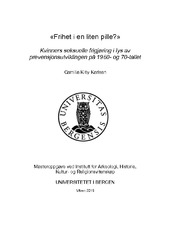| dc.description.abstract | In this thesis I aim to analyse the Norwegian understanding of women and their sexuality during the 1960s and 70s, in light of the Norwegian debate on new methods of birth control, and how the birth control pill has affected Norwegian women’s health and situation. I do this by analysing contemporary non-fiction literature, newspaper articles and other sources that discuss these subjects. Women’s sexuality has historically been linked to reproduction, as children are the unpreventable result of unprotected cis-gendered heterosexual intercourse. Due to this, women have been included in society as mothers, not as women. I have found that birth control has been important for women to be able to participate in society without worrying about unwanted pregnancies. Female sexuality has been forbidden in the sense that it was to be exercised behind closed doors, preferably in the marriage bed. Considering that sexual relations before safe methods of birth control meant a risk of getting pregnant, women’s sexuality has been restrained by social norms. This has caused for the discourse regarding female sexuality to be largely based around love and family, while the aspect of pleasure has been mostly disregarded. Based on my analysis I have found that women were often responsible for using birth control. This has become especially clear after the birth control pill was released on the Norwegian pharmaceutical market in 1967. The debate clearly indicates that women also were responsible for men’s sexual behaviour, as men were often excused as being unable to control their own sexual urges. The birth control pill has been key in my analysis, and while the societal effects of the pill has been largely in women’s advantage both when it comes to practical living, and the possibility for a pleasurable sex life, there are also some problematic points in regard to the side effects. The pill was first released on the US market in 1960, and even though it took seven years for the pill to be approved in Norway, there was little knowledge about the actual side effects of the pill. Well into the 1970s it’s clear that no one quite knew how the pill affected women. I claim that this can possibly be linked to the understanding that women are controlled by their nature and emotions, and the opposite to men, who represent culture and reason. | en_US |
